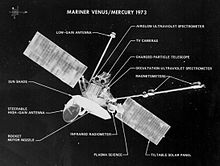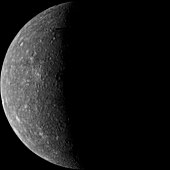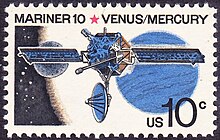Mariner
The Mariner program (Mariner. Closely to mariners) of the NASA was used to explore the Earth-like planet of the solar system , so Mercury , Venus and Mars . A total of ten space probes were launched between 1962 and 1973.
Missions
With the exception of Mariner 5 and 10, all marine probes were probe pairs, i.e. two probes of the same design were started relatively quickly one after the other, in the same start window . At Mariner 10, too, there was a rocket on another launch pad with a spare copy in the event of a false start. However, the replacement copy did not start after the successful launch of Mariner 10. The space probes weighed between 200 (for Mariner 1 and Mariner 2) and 1000 kilograms (for Mariner 8 and Mariner 9), Mariner 1, 2 and 5 had no cameras on board. The Mariner probes 1 to 5 flew into space on the Atlas-Agena launcher , the Mariner 6 to 10 probes on an Atlas-Centaur , three of the probes suffered false starts.
The planned missions "Mariner 11" and "Mariner 12" were later renamed and executed as Voyager 1 and Voyager 2 due to the structural differences between the probes .
Mariner 1 and 2
Mariner 1 and 2 were based on the Ranger moon probes and were developed relatively quickly - in less than a year - to successfully send a probe to Venus before the USSR . The instrumentation was due to the low power of the carrier rocket Atlas Agena B modest and comprised very detectors for cosmic rays , dust and charged particles, magnetometers , and for the exploration of a Venus infrared and microwave radiometers . The biggest challenge was to build a spacecraft that could work 2500 hours in interplanetary space. The Ranger probes on which Mariner 1 and 2 were based should only be active for a few days. Mariner 2 weighed 202.8 kg, of which 18.6 kg were used for the experiments. The probes were built by JPL for NASA , the US federal aerospace agency.
Mariner 1 was lost during launch on July 22, 1962 due to a faulty control program when the launcher went off course and had to be blown up 293 seconds after launch. A developer had overlooked an overline in the handwritten specification of a program for controlling the drive and thus used raw data instead of smoothed measured values, which led to incorrect and potentially dangerous malfunctioning of the drive.
Mariner 2 started on August 27, 1962 and already discovered the solar wind postulated by Ludwig Biermann in the 1950s on the way to Venus . Problems with the probe soon arose: after a course correction on September 4, 1962, the pressure in the nitrogen tank rose and fuel escaped. A further course correction was no longer possible. At the end of October the performance of one of the two solar panels decreased , which failed completely on November 15th, 1962. However, as the probe approached the sun , the current from the second panel was sufficient to operate the probe. Further defects followed, but could be repaired from Earth. When the probe passed Venus on December 14, 1962 at a distance of 34,773 km and all measuring instruments provided data, NASA joked that the abbreviation JPL stood for "Just Plenty of Luck" (Eng. "Simply a lot of luck") . On January 3, 1963, Mariner 2 finally failed.
The probe determined the temperature of Venus to be 425 degrees Celsius , could not detect any water vapor in the atmosphere and determined the upper height of the cloud layer to be around 55 to 80 km.
Mariner 3 and 4
Mariner 3 and 4 were targeted to fly by Mars. The somewhat more powerful Atlas Agena D made it possible to launch a 260.8 kg probe. 15.8 kg of this was accounted for by the experiments. The span of the probes was 6.88 m and the height 2.89 m. Mariner 3 and 4 used a TV camera for the first time, but their image quality was very poor. An image was only 200 lines with 200 dots. During the flyby , the images were saved on a tape recorder that could record 22 images. The transmission to earth took over 8 hours per image.
The experiments also included a magnetometer and various detectors for dust, charged particles and high-energy rays. These devices were also active during the flight to Mars. Half of these experiments failed with Mariner 4 on the way to Mars.
Mariner 3 started on November 5, 1964. For the first time, a new, lightweight payload fairing made of glass fiber reinforced plastic was used . However, this melted due to the frictional heat during the ascent and stuck to the probe. So the solar panels could not be extended and the probe had to remain in earth orbit because it was too heavy to get to Mars.
The launch of Mariner 4 was postponed and a new metal payload fairing was made. Mariner 4 was launched on November 28, 1964 and was the first terrestrial spacecraft ever to pass Mars on July 15, 1965 at a distance of 9844 kilometers. The probe took 22 images in 22 minutes, which were sent to Earth over the next few days. They showed a very moon-like Mars, but only covered 1% of the surface. Furthermore, it was found that Mars has no or only a very weak magnetic field . The atmosphere has a ground pressure of a maximum of 30 mbar and consists of 80 to 100% carbon dioxide and a maximum of 16% nitrogen or 8% argon . Communication with the probe was possible until December 20, 1967.
Mariner 5
Mariner 5 was one of the two single missions in the program. A reserve copy of Mariner 3 and 4 was launched to Venus. Changes in the probe resulted from Venus being closer to the sun. A protective shield was attached to the bottom of the probe and the solar panels were made smaller. The 245 kg probe had a wingspan of 5.48 m and was 2.89 m high. The equipment for experiments weighed 15.8 kg. They were largely identical to those on board Mariner 3 and 4, but a UV photometer replaced the camera and an additional component made it possible to send a carrier wave with a precisely defined frequency .
The main mission of the probe, launched on June 14, 1967, was to disappear behind Venus and transmit a pure carrier wave whose frequency, phase and amplitude changes were determined on Earth. This made it possible to determine properties of the ionosphere , atmosphere and the internal composition of Venus.
Mariner 5 completed a successful flyby of the planet Venus on October 19, 1967 and provided numerous scientific data. It was found that Venus has a mean radius of 6051.8 km, is hardly flattened and the atmosphere must be very dense. The ground pressure was estimated at 75 to 100 bar and the ground temperature at 500 degrees Celsius.
Mariner 6 and 7
Mariner 6 and 7 were two other flyby probes. You should pass Mars and get more and better resolution images than Mariner 4. The availability of the Atlas Centaur launcher made it possible to launch much heavier probes. Mariner 6 and 7 weighed 412.8 kg each, 57.6 kg of which were used for the experiments. For the first time there was also a program control on board. The experiments to investigate interplanetary space were dispensed with and the probes were given two cameras, a UV spectrometer and an infrared radiometer.
Mariner 6 took off on February 24, 1969. It was sent on a very fast orbit and passed Mars on July 31, 1969. As a result, the flyby distance of 3430 kilometers was considerably less than that of Mariner 4. This and further improvements to transmitters and receivers allowed transfer an image within a few minutes. The probe first took 50 images of Mars from a greater distance, which showed the entire planet, then took another 25 images with the wide-angle camera during the flyby, which were transmitted directly.
Mariner 7 launched on March 27, 1969. On August 2, 1969, the probe took 93 images as it approached, covering two full rotations of the planet. There were another 33 pictures at the passage. Both probes passed Mars in the southern hemisphere and mapped 20 percent of the surface. The ground pressure and the temperatures could be determined more precisely. On recordings from Mariner 7, the size of Phobos , the larger of the two Martian moons, was determined to be 22.4 × 17.6 km. The photos, which were published one or two weeks after the return of the Apollo 11 astronauts, met with a sensitized public.
Mariner 8 and 9
Mariner 8 and 9 were tasked with entering orbit around Mars for the first time. The probes were based on Mariner 6 and 7, but were considerably heavier, as they now also had an engine and propellants for braking into Mars orbit. Mariner 8 and 9 weighed 998 kg each, of which 63.1 kg were the instruments. These devices were improved versions of those of Mariner 6 and 7, with the addition of an infrared spectrometer. The camera in particular has been greatly improved and took significantly sharper images than Mariner 6 and 7.
Originally, Mariner 8 was supposed to map the planet with the wide-angle camera and Mariner 9 should record particularly interesting areas with the telecamera in detail. After the false start of Mariner 8 on May 8, 1971, caused by a defective diode in the control computer of the Centaur upper stage, the program of Mariner 9 was changed. Mariner 9 took off on May 30, 1971. On November 14, 1971, the probe fired its engine for 915.6 seconds and swiveled into a 1397 km x 17,616 km orbit with an inclination of 64.28 degrees. Mariner 9 was the first terrestrial probe to go into orbit around another planet. At that time, the largest dust storm since 1953 was raging on Mars, so the first photos only showed the peaks of a few high volcanoes . At the beginning of 1972 the atmosphere cleared and Mariner 9 began mapping Mars. Surface temperatures and the composition of the atmosphere were determined.
The time between the observation of detailed regions has been extended from five to 17 days. Every day the probe made 21 hours of recordings (max. 36) on the tape recorder and transmitted them to earth for the remaining three hours. Most of the time, the recordings were made near the point closest to Mars. Already in July 1971 a leak was noticed in the nitrogen tank, which was used for position control with 176 bar pressure . This limited the duration of the mission, because the probe was now constantly losing nitrogen and the pressure dropped. After 349 days in orbit, on October 27, 1972, the compressed gas was exhausted and the probe was switched off. By then it had transmitted 7,329 images to earth.
Mariner 10
Mariner 10 , the last of the Mariner series, was again a flyby probe - but with very complex orbit maneuvers . She was to visit Mercury , the planet closest to the sun, for the first time . It was the first space probe ever to use a planet, in this case Venus , for a swing-by maneuver that relayed the probe to Mercury. In order to get to Mercury from the earth near the sun, a probe has to reduce its orbital energy, which it received from the earth's orbital speed, by around 60 percent. The braking swing-by enabled the cheaper Atlas Centaur to be used as a launch vehicle instead of the Titan IIIC . In addition, the use of the X-band meant that the data could be transferred much faster. The probe was based on the bus from Mariner 8 and 9, but had to be modified for the short solar distance. The total takeoff mass was 503 kg. The probe was built by Boeing . The instruments, including two cameras, weighed 78.2 kg and included seven experiments.
After launching on November 3, 1973, the probe passed Venus on February 5, 1974, from which it transmitted 4,165 images. Mercury was first passed on March 29, 1974 at a distance of 705 km, with 2450 images being transmitted. This was the first time a space probe had arrived on this planet. Mercury redirected the probe into a 176-day orbit around the sun. Since Mercury itself orbits the Sun in 88 days, the probe and Mercury met again at the same point in Mercury's orbit after 176 days. Mercury rotates around its own axis once every 59 days, however, and so it always turns to the same side of the sun after three sidereal rotations ( sidereal days). The next encounter on September 21, 1974 took place at a greater distance of about 50,000 km so as not to influence the orbit of the probe by the gravitation emanating from Mercury. The last encounter on March 16, 1975, however, brought up to 375 km to Mercury in order to better study the magnetic field. On March 24, 1975, the supplies of fuel were exhausted and the probe was switched off. Mariner 10 was the only Mercury probe until March 2011 (when MESSENGER arrived at Mercury).
Results
- The Mariner program was considered a great technical success: There were only three false starts (success rate 70%), which was a very good value for the pioneering days of space travel .
- The USA was the first nation to provide images of all inner planets before the USSR .
- 45% of the planet Mercury was captured photographically by Mariner 10 (about 9000 individual images).
- The planet Venus was explored by Mariner 2, 5 and 10, although the US interest in this planet declined noticeably afterwards. Only one probe from the Mariner program, Mariner 10, also took pictures of the planet. The Soviet Union made the first soft landing on an alien planet with Venera 7 .
- The planet Mars attracted more attention: Mariner 4 explored about 1% of the surface, Mariner 6 and 7 about 20%. With the first Mars orbiter , Mariner 9, the first Mars map was created, albeit of poor quality.
- The Mariner program has shown that life like on Earth is impossible on Mars.
See also
Web links
- extrasolar-planets.com: Mariner probes
- NASA: Mariner Space Probes (English)
- JA Dunne, E. Burgess: The voyage of Mariner 10: Missions to Venus and Mercury. Prepared by Jet Propulsion Laboratory, California Institute of Technology, 1978, (NASA-SP-424)
- Merton E. Davies, Stephen E. Dwornik, Donald E. Gault, Robert G. Strom: Atlas of Mercury. Prepared for the Office of Space Sciences, National Aeronautics and Space Administration Scientific and Technical Information Office, 1978, (NASA-SP-423)
- NASA: Mariner-Venus 1962. Final Project Report (English, PDF, 6 MB)
Individual evidence
- ↑ Mariner 10 at Skyrocket
- ^ Peter Neumann: Mariner I - no holds BARred. The Risks Digest Volume 8: Issue 75, May 27, 1989, accessed March 29, 2016 .













